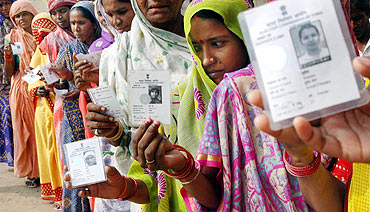 | « Back to article | Print this article |
How BJP, JD-U mastered the numbers game
This is the third election in Bihar in the last five years. And Chief Minister Nitish Kumar's Janata Dal United -Bharatiya Janata Party combine has been going from strength to strength: From 75 seats in February 2005 to 146 in October that year to more than 200 this time.
A look at how today's results stack up against the numbers from five years ago.
February 2005:The electorate gave a fractured mandate: 92 to the JDU-BJP combine and 75 to the RJD.
The LJP emerged kingmaker with 29 MLAs, and the Congress finished a distant fourth with 10.
Ram Vilas Paswan was reluctant to side with any party in the hung house, and forced another election on the state, following a brief spell of President's rule.
Compiled by Krishnakumar P Graphics Reuben N V
How BJP, JD-U mastered the numbers game
October 2005:
The Congress, chastised by the poor showing in February, opted to go with its United Progressive Alliance ally RJD. The LJP fought alone again.
All three major contenders urged the electorate to give a clear verdict in the ensuing election. The people rejected Paswan's LJP outright, reducing it to 11 seats. The RJD-Congress combine took 65 seats. But the people had decided to give the BJP-JD-U combine a simple majority of 146 in the 243-member house.How BJP, JD-U mastered the numbers game
November 2010:
Following a term that was praised by all quarters, the JD-U went to the people asking for a second term based on its good governance and development.
Lalu tried to salvage a losing battle by invoking old caste equations. The Congress decided to go it alone, wanting to the test the waters. The people gave the JD-U's numbers a 150 percent increase, as the rest were swept away. The BJP too has not done badly. From 37 seats out of 104 in February 2005, to 55 off 102 in October 2005, the party seems close to securing nearly 80 seats this time. That will give the BJP an astounding conversion rate. It also shows that rather than leading the fight, the party works best in a coalition. And most importantly, is this a sign that the BJP works best in an able ally's slipstream, rather than when it is spearheading the battle? Any lessons for the 2014 general elections here?

